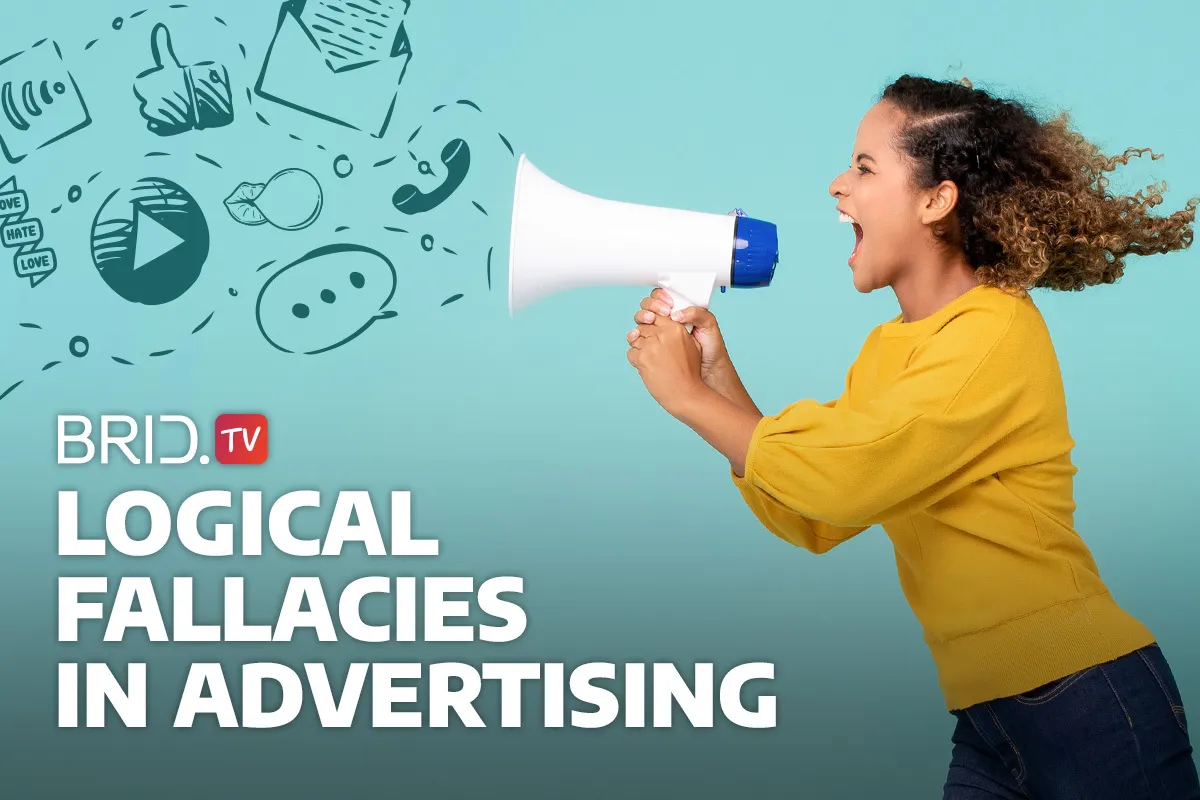Creating advertisements is no easy task. Convincing an audience to buy your product or service can take a lot of persuasion. Sometimes, we may resort to logical fallacies when advertising to do this. Unfortunately, more often than not, these are not the best tools to convince potential customers to do business with you. But what are logical fallacies anyway and are they ever effective? Should you steer clear of them or are there instances when they can work in your favor?
- What Are Logical Fallacies in Advertising?
- Why Are Fallacies Used in Advertising?
- Are Fallacies in Advertising Effective?
-
Examples of Logical Fallacies in Advertising
- Ad Hominem
- Ad Populum (The Bandwagon Appeal)
- Argumentum Ad Ignorantiam (Appeal to Ignorance)
- Argumentum Ad Misericordiam (Appeal to Pity)
- Argumentum Ad Verecundiam (Appeal to Authority)
- Petitio Principii (Begging the Question)
- Circular Argument
- False Dilemma Fallacy
- Sunk Cost Fallacy
- Genetic Fallacy
- Hasty Generalization
- False Equivalence
- Post Hoc Ergo Propter Hoc
- Red Herring
- Slippery Slope
- The Strawman
- Tu Quoque
- Should You Use Logical Fallacies in Advertising?
What Are Logical Fallacies in Advertising?
Fallacies are logically flawed statements that can significantly weaken your arguments. Many of us use them every day without even knowing, especially if we enter a heated argument where emotions run rampant. For example, you may dismiss your interlocutor’s point of view on a topic based on their political stance or counter-attack them for criticizing you for something they themselves are guilty of.
But logical fallacies are not strictly a thing of interpersonal conversation. They are a common persuasion tactic in advertising campaigns, from old-school billboards to digital video advertising. Their goal is often to provoke some sort of an emotional reaction in their viewers. After all, using emotion in video marketing has proven to be an effective advertising tool.
Why Are Fallacies Used in Advertising?
You might be wondering — if logical fallacies tend to weaken one’s argument, shouldn’t advertisers steer clear of them? If that is the case, why are some of the best commercials full of fallacies? After all, some of the most controversial ads, such as the notorious Pepsi commercial featuring Kendall Jenner, have faced criticism precisely because they rely on logical fallacies.
The truth is, if done right, logical fallacies in ads can be quite inconspicuous and much harder to notice if you’re not actively looking for them. In such cases, they have the power to trick the viewer into thinking they are being presented with valid arguments and facts. That is not to say that using fallacies always implies false advertising, more so that they leave room for it.
Are Fallacies in Advertising Effective?
As we’ve already mentioned, despite the questionable morality of using logical fallacies in advertising, they do have the power to launch an ad campaign into stardom. If you watched TV or used the internet back in the late 2000s, the chances are that you’ve seen Apple’s Get a Mac campaign. What turned out to be one of the most successful ad campaigns for Apple (it increased Mac sales by over 30% and even won an award) was actually riddled with fallacies — and it didn’t even try to hide it.
The campaign included a series of advertisements featuring two people — one representing the Apple Macintosh, and the other one acting as the PC. The two people would perform skits comparing each other’s features and specs. The ads implied that PC users tend to be boring, unpopular nerds, while Apple users are hip, cool, and attractive.
Examples of Logical Fallacies in Advertising
Can you identify some of the fallacies featured in Apple’s campaign? If not, we’re here to help. Let’s take a look at some of the most common logical fallacies, how they’re used, as well as a few examples of ads with fallacies.
Ad Hominem
The ad hominem fallacy implies an attack on a person’s integrity or character rather than their argument. It is used to discredit the opponent or the subject of the claim and make them seem less credible.
Ad Hominem Example:
Person A: Sigmund Freud revolutionized psychology and is still considered an authority on many psychological matters.
Person B: Freud was a cocaine addict, so I wouldn’t consider him an authority on anything.
This is one of the most common logical fallacies in political debates and campaigns.

Ad Populum (The Bandwagon Appeal)
The bandwagon appeal is based on the assumption that the popularity of a product or service is proof of its value or quality. In other words, it aims to convince people to hop on the bandwagon.
Ad Populum Example:
The iPhone is the best mobile phone out there since almost everyone has it.
As one of the most effective logical fallacies out there, the bandwagon is regularly used in advertising.
Argumentum Ad Ignorantiam (Appeal to Ignorance)
Ad Ignorantiam, also known as an appeal to ignorance, is a logical fallacy that assumes that just because we don’t have proof that something is true, it must not be true (or vice versa: just because we don’t have proof that something is false, it must be true).
Ad Ignorantiam Example:
There is no proof that vaccines work, so they must not actually work!
Ad ignorantiam is a relatively common fallacy in everyday communication, and it is relatively easy to commit without even knowing. However, it is not necessarily a strong persuasion tool, so its use in advertising is quite limited.
Argumentum Ad Misericordiam (Appeal to Pity)
Argumentum ad misericordiam is a fallacy that appeals to a person’s sense of pity. Not only is this a commonly used logical fallacy, but it is also a quite popular manipulation tactic. Unfortunately, this also means that it can be quite effective.
Ad Misericordiam Examples:
- Nobody wants to help around in this house. But you’ll see when I’m gone.
- Ms. Jackson, please give me a passing grade. My dad will be furious if I fail.
- Don’t leave me — I’m nothing without you!
Needless to say, as an effective persuasion tool, appeal to pity is common in commercials — particularly those focusing on charities and donations.

Argumentum Ad Verecundiam (Appeal to Authority)
People tend to believe those who they perceive as authority figures, be it a parent, a teacher, a boss, or an industry expert. The ad verecundiam fallacy takes advantage of that.
Ad Verecundiam Example:
- My dad said Santa is real, and my dad knows everything!
Appeal to authority tends to be quite effective due to our tendency to believe those people we see as more knowledgeable. Needless to say, this makes it one of the favorite persuasion techniques for many advertisers.

Petitio Principii (Begging the Question)
Begging the question, or petitio principii in Latin, is a fallacy that uses itself to prove its own veracity. It basically claims that X is true because it is.
Petitio Principii Example:
- Eating too much sugar is unhealthy because sugar has a negative effect on health.
In other words, petitio principii entails reiterating the same fact to establish its trustworthiness. It is not exactly the most persuasive fallacy out there, so it is not that common in advertising.
Circular Argument
The circular argument is the previous fallacy’s more covert sibling. However, there is one big difference: while petitio principii is based on a single reiterated statement, the circular argument creates a chain of statements that prove one another true, only to circle back to the original one. It claims that X is true because Y is true and Y is true because (Z is true, and Z is true because) X is true.
Circular Argument Example:
- I believe in God because the Bible says that God is real, and the Bible came from God.
False Dilemma Fallacy
The false dilemma fallacy is pretty easy to spot if you know what you’re looking for. As the name suggests, it presents a choice between two options without considering that there are other options outside of the two offered. It can also be a manipulation tactic.
For example, let’s imagine a parent trying to convince their child to eat more vegetables. The parent might ask “Do you want vegetables for dinner?” (to which almost any child would just say no). However, the parent could also ask “Would you rather have carrots or cauliflower with your dinner?” This gives the child a false sense of having a say in the matter, even though the result is the same — they will eat more veggies.

Sunk Cost Fallacy
The sunk cost fallacy has its roots in economics. It assumes that, since you have already invested time, money, or effort into something, you should keep investing, regardless of low or non-existent returns. However, the sunk cost fallacy is not limited to finances. It can refer to anything from reading a book to interpersonal relationships.
Sunk Cost Fallacy Example:
- I’m not happy in my relationship anymore, but we have been together for so long that I don’t want to give up.
Genetic Fallacy
The genetic fallacy can be quite problematic and usually carries with it an array of biases and prejudices. It entails the assumption that an object’s or a person’s background or origin defines the qualities of said object or person.
Genetic Fallacy Examples:
- The best car you can buy is any car coming from Germany.
- He is a Muslim so he must not respect women.

Hasty Generalization
The hasty generalization fallacy is pretty self-explanatory. It entails drawing conclusions based on limited information or generalizing a group based on a small number of individuals belonging to it.
An example of hasty generalization would be a research study that has a small number of participants or a person swearing off a particular restaurant because they were dissatisfied with the service once. It could also avoid taking into consideration all information available for the purpose of presenting data in a certain way, such as the banner below:

This diet pill advertisement relies on the fact that you will hastily conclude that the woman in the photo has lost weight thanks to the product. It disregards the possibility that she might have stuck to a strict diet, exercised regularly, or had weight loss surgery, for example.
False Equivalence
False equivalence is a logical fallacy that demonstrates that two objects or people are on the same level despite apparent differences. For example, one might compare their boss to a slave owner to demonstrate how demanding the boss is, even though there is an obvious difference between the two.

False equivalence is one of the more common logical fallacies in ads, as it can demonstrate the superiority of a certain product compared to, for example, its more expensive alternatives (even though, in most cases, a higher price indicates higher quality).
Post Hoc Ergo Propter Hoc
Post hoc ergo propter hoc (or just post hoc for short) is a fallacy that assumes correlation indicates causation. In other words, just because two events took place one after the other, according to post hoc, that means that the first event caused the following one. A good example would be a child assuming that, just because a rooster crows right before sunrise, the rooster actually causes the sun to rise.
Post hoc is one of the most common fallacies on TV, as advertising campaigns often focus on selling an idea before selling the product. Commercials for men’s toiletries tend to focus on the increased chance of attracting a partner, while commercials for diapers, for example, imply that the right diaper will make the baby happier and calmer.
Red Herring
Put simply, the red herring fallacy entails changing the topic from an issue at hand to something irrelevant (or only seemingly relevant). The purpose of this fallacy is to take the focus away from the issue at hand, and it can be a clear indicator of a weak argument.
One of the most viral marketing videos of all time, the Old Spice commercial featuring Isaiah Mustafa, is riddled with fallacies, red herring being one of them. Instead of focusing on the actual qualities of the product (quality ingredients, great smell, reasonable price), the commercial takes us on a wild ride from a man’s bathroom to a beach and a horse. It insinuates that using Old Spice will make a man desirable, rich, and exciting to be around.
Slippery Slope
You can think of the slippery slope fallacy as a chain of red herrings. Slippery slope assumes that, because A happened, this will make B happen, which will make C happen, and so on. The result is usually overly dramatic and out of proportion with the initial event. One of the most famous examples of a slippery slope is the iconic sex ed scene from the movie Mean Girls.
Slippery Slope Example:
Coach Carr: Don’t have sex because you will get pregnant and die! … If you touch each other, you will get chlamydia and die.
The Strawman
The strawman fallacy is the act of oversimplifying or misconstruing the opposition’s argument to attack it. It is one of the most widely used fallacies in real life. It usually indicates bias and a lack of a strong argument.
The Strawman Fallacy Examples:
- Mother: You can’t go to the party until you’ve done your homework.
- Daughter: You don’t want me to have a social life at all!
- Politician One: I am opposed to a complete firearm ban and advocate for stricter regulation instead.
- Politician Two: My opponent does not care about our children’s lives.
The iconic Budweiser commercial from the 2015 Super Bowl is a great example of the strawman fallacy in advertising. On top of telling the audience that Budweiser is superior in quality to craft beer, it also implies that people who drink craft beer, debate the nuances of its flavor, and “fuss over it” don’t actually like beer at all.
Tu Quoque
Tu quoque roughly translates to “you too”, and that is exactly what this fallacy is about. It discredits the opponent’s argument for being hypocritical. This is one of the most common logical fallacies, as it is a powerful tool for disarming an opponent.
Tu Quoque Fallacy Examples:
- Smoking is bad for you. You should quit.
- You have been smoking all your life, who are you to tell me.
- You should eat fewer sweets; they’re not good for you.
- I saw you have cake for breakfast this morning.

Should You Use Logical Fallacies in Advertising?
Now that we’ve taken a look at some ads and commercials with fallacies, you probably have a better grasp of their effectiveness. Although they should not be the go-to persuasion tools in your campaign, if implemented correctly, they do have the power to attract more potential customers. Still, it is better to stick to some more effective rhetorical devices to make your ads more persuasive if possible.
And if you need an HTML5 player to monetize your videos or play your ads (whether they contain logical fallacies or not), Brid.TV’s platform is there for all your needs. Check out how to host, manage, and monetize videos with Brid.TV.

